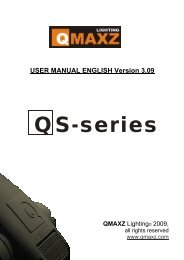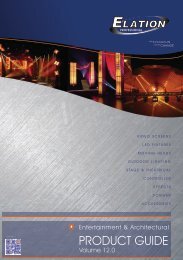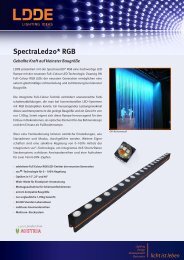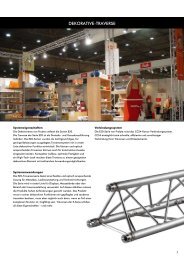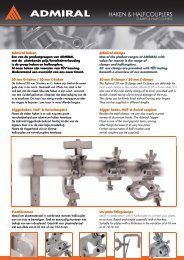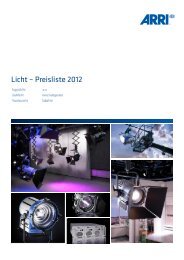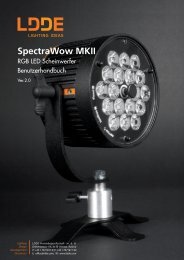Schneider Filters - Lightequip
Schneider Filters - Lightequip
Schneider Filters - Lightequip
You also want an ePaper? Increase the reach of your titles
YUMPU automatically turns print PDFs into web optimized ePapers that Google loves.
12<br />
®<br />
True-Pol<br />
Polarizing<br />
<strong>Filters</strong><br />
Applications: The most effective<br />
polarizer made for cine and electronic<br />
cameras, <strong>Schneider</strong> True-Pol ® filters<br />
have an extinction ratio of ER 374,<br />
twelve times more effective than other<br />
such filters! Unmatched in ability to:<br />
• Reduce glare & unwanted reflections<br />
• Saturate colors<br />
• Deepen blue skies<br />
• Improve contrast<br />
• Penetrate haze<br />
True-Pol ® Linear Polarizer<br />
True-Pol filters utilize polarizing film<br />
which is laminated between two<br />
pieces of <strong>Schneider</strong>’s crystal-clear,<br />
water-white optical glass. The filter<br />
is protected against edge-chipping and<br />
delamination by <strong>Schneider</strong>’s unique<br />
Edge Seal process, which also reduces<br />
edge reflections and flare.<br />
The absolute clarity of the glass<br />
combined with advanced polarizing<br />
material make True-Pol filters particularly<br />
useful on demanding scenes,<br />
like shooting through windshields in<br />
rigged vehicles. Cinematographers report<br />
that True-Pol filters capture more color<br />
saturation, wider tonal range and<br />
greater contrast inside the car.<br />
Sizes: 4”x 4”, 4”x 5.65” (Panavision<br />
size), 5”x 5”, 5.65”x 5.65”, 6.6”x 6.6”<br />
and rounds in Series 9, 4.5”, 138mm,<br />
6” 9.5”, 40.5 & 48mm.<br />
For maximum color saturation when<br />
filming an actor or darkening blue skies,<br />
the polarizer and lens-subject axis<br />
should be positioned 90 degrees from<br />
the sun or light source.When reducing<br />
glare and reflections in a window scene,<br />
it is recommended to position the lenspolarizing<br />
axis approximately 34<br />
degrees to the window.<br />
Without True-Pol With True-Pol<br />
One-Stop Linear Polarizer<br />
Applications: Low light such as<br />
indoors or night requiring elimination<br />
of glare and reflections off surfaces<br />
like car and storefront windows.<br />
While the standard True-Pol is 1 3/5<br />
stops, the One-Stop Linear Polarizer<br />
significantly reduces reflections while<br />
reducing available light by just one stop.<br />
Sizes: 4”x 4”, 4”x 5.65” (Panavision<br />
size), 5”x 5”, 5.65” x 5.65”, 6.6”x 6.6”<br />
Special orders for 6”, 138mm, 4.5”,<br />
& 9.5” rounds as well as 40.5mm &<br />
48mm threaded behind-the-lens filters<br />
(with anti-reflection multi-coating)<br />
Screw-on Polarizers for<br />
Video Lenses<br />
The Top-Pol and Kaesemann Pol employ<br />
<strong>Schneider</strong>’s brass mounting rings to<br />
virtually eliminate jamming on the<br />
lens barrel. ENG camera operators,<br />
concerned with vignetting during wideangle<br />
operation, may be interested in<br />
<strong>Schneider</strong>’s Slim-Line circular polarizers,<br />
part of <strong>Schneider</strong> Optics B+W filter<br />
line. See www.schneideroptics.com<br />
The most convincing performance test of a<br />
polarizing filter is achieved by overlapping<br />
two & shining a light through the pair.<br />
When one filter is turned & the other is<br />
held stationary, the density of the two filters<br />
should go from slightly gray to almost<br />
black. The more light passing through the<br />
filters at maximum density, the weaker<br />
the polarizing effect.<br />
Circular<br />
®<br />
True-Pol<br />
for<br />
Video Assist &<br />
3-D Projection<br />
Application: To prevent viewfinder<br />
black-out on cameras which employ<br />
polarizing elements in the beam-splitters<br />
of the viewing system, like Arriflex<br />
435 and MovieCam Compact.<br />
Camera beam splitters send light in two<br />
directions: to an eyepiece and to a video<br />
tap. Light in a camera’s viewing system<br />
can become polarized, and when a<br />
standard (linear) polarizing filter is<br />
attached to the lens, the light becomes<br />
cross polarized. This hinders visibility<br />
and can create total blackout of the<br />
viewing image and/or the video tap.<br />
<strong>Schneider</strong> Circular Polarizers<br />
employ a two-layer design to prevent<br />
blackout. The first layer is composed<br />
of the same polarizing substance used<br />
in all True-Pol filters. The second layer<br />
is composed of a 1/4-wave retarder<br />
plate to prevent cross-polarization.<br />
To ensure correct placement<br />
on the lens barrel, <strong>Schneider</strong> clearly<br />
marks the outer surface of Circular<br />
True-Pol filters.<br />
Available in Left and Right hand<br />
polarization for projection in standard<br />
and custom sizes.<br />
Sizes: 4”x 4”, 4”x 5.65” (Panavision<br />
size), 5”x 5”, 5.65”x 5.65”, 6.6”x 6.6”<br />
and 138mm Round<br />
Without polarizing filter<br />
With polarizing filter<br />
T R U E - P O L ®<br />
Without True-Pol<br />
With True-Pol<br />
Polarizers are Versatile<br />
Tools<br />
Polarizers are commonly used to<br />
control glare on water and to allow<br />
the camera to see below the surface.<br />
They are also used to reduce glare<br />
on car bumpers and control reflections<br />
on plate-glass windows. Polarizers<br />
are so versatile they can also perform<br />
the opposite functions. Some use<br />
polarizers to increase or enhance<br />
reflections, simply by changing the<br />
filter’s setting.<br />
Ideal for:<br />
• Darkening skies for dramatic impact.<br />
While graduated neutral density<br />
filters can also be used to achieve<br />
this effect, the need to position<br />
their transition line accurately<br />
precludes their use in many<br />
applications. Polarizers do not<br />
suffer from this limitation.<br />
• Suppressing reflections & capturing<br />
truer color when filming actors<br />
through a windshield and from<br />
other rigged-car camera positions.<br />
• Greatly adding to the drama and<br />
appeal of the shot when shooting<br />
food (particularly meat or liquids).<br />
• Increasing the color saturation of<br />
any object with a glossy surface. 13



